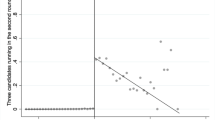Abstract
Using ADA roll call voting scores for the 1947–2006 period, I find that senators shirk in their last term. The degree of shirking is limited by political parties, which constrain the politician in his last term, and varies by post-Senate career choices. The results highlight the importance of political parties in the repeated game that is electoral politics.
Similar content being viewed by others
References
Alesina, A. (1988a). Credibility and policy convergence in a two-party system with rational voters. The American Economic Review, 78(4), 796–805.
Alesina, A. (1988b). An overlapping generations model of electoral competition. Journal of Public Economics, 37, 359–379.
Anderson, S., & Habel, P. (2008). Revisiting adjusted ADA scores for the u.s. congress, 1947–2007. Political Analysis, 17, 83–88.
Ansolabehere, S., & Snyder, J. M. (2004). Using term limits to estimate incumbency advantages when officeholders retire strategically. Legislative Studies Quarterly, 39(4), 487–515.
Barro, R. J. (1973). The control of politicians: An economic model. Public Choice, 14, 19–42.
Becker, G. S., & Stigler, G. J. (1974). Law enforcement, malfeasance, and the compensation of enforcers. The Journal of Legal Studies, 31(1), 1–18.
Bender, B., & Lott, J. R. (1996). Legislator voting and shirking: A critical review of the literature. Public Choice, 87, 67–100.
Besley, T., & Case, A. (1995). Does electoral accountability affect economic policy choices? Evidence from gubernatorial term limits. The Quarterly Journal of Economics, 110(3), 769–798.
Bronars, S. G., & Lott, J. R. (1997). Do campaign donations alter how a politician votes? Or, do donors support candidates who value the same things that they do? Journal of Law and Economics, 40(2), 317–350.
Carey, J. (1994). Political shirking and the last term problem: Evidence for a party-administered pension system. Public Choice, 81, 1–22.
Dougan, W. R., & Munger, M. C. (1989). The rationality of ideology. Journal of Law and Economics, 32(1), 119–142.
Fenno, R. F. (1978). Home style: house members in their districts. Boston: Little Brown.
Figlio, D. N. (1995). The effect of retirement on political shirking: Evidence from congressional voting. Public Finance Quarterly, 23, 226–241.
Figlio, D. N. (2000). Political shirking, opponent quality, and electoral support. Public Choice, 103, 271–284.
Gowrisankaran, G., Mitchell, M. F., & Moro, A. (2008). Electoral design and voter welfare from the us senate: Evidence from a dynamic selection model. Review of Economic Dynamics, 11(1), 1–17.
Groseclose, T., Levitt, S. D., & Snyder, J. M. (1999). Comparing interest group scores across time and chambers: Adjusted ADA scores for the u s congress. American Political Science Review, 93(1), 33–50.
Hansen, L. (1982). Large sample properties of generalized method of moments estimators. Econometrica, 50(3), 1029–1054.
Hausman, J. A. (1978). Specification tests in econometrics. Econometrica, 46(6), 1251–1271.
Kleibergen, F., & Paap, R. (2006). Generalized reduced rank tests using the singular value decomposition. Journal of Econometrics, 133(1), 97–126.
Levitt, S. D. (1996). How do senators vote? disentangling the role of voter preferences, party affiliation, and senator ideology. American Economic Review, 86(3), 425–441.
Levy, G. (2004). A model of political parties. Journal of Economic Theory, 115(2), 250–277.
Lott, J. R. (1987). Political cheating. Public Choice, 52, 169–186.
Lott, J. R. (1990). Attendance rates, political shirking, and the effect of post-elective office employment. Economic Inquiry, 28(1), 133–150.
Lott, J. R., & Reed, W. R. (1989). Shirking and sorting in a political market with finite-lived politicians. Public Choice, 61(1), 75–96.
Peltzman, S. (1984). Constituent interest and congressional voting. Journal of Law and Economics, 27(1), 181–210.
Poole, K., & Rosenthal, H. (1997). Congress: a political-economic history of roll call voting. New York: Oxford University Press.
Stewart, C. I., & Woon, J. (2006). Congressional membership data, 80th to 109th congresses, 1947–2006: Senate.
VanBeek, J. R. (1991). Does the decision to retire increase the amount of political shirking? Public Finance Review, 19(4), 444–456.
Zupan, M. A. (1990). The last period problem in politics: Do congressional representatives not subject to a reelection constraint alter their voting behavior? Public Choice, 65, 167–180.
Author information
Authors and Affiliations
Corresponding author
Rights and permissions
About this article
Cite this article
DeBacker, J. Political parties and political shirking. Public Choice 150, 651–670 (2012). https://doi.org/10.1007/s11127-010-9722-6
Received:
Accepted:
Published:
Issue Date:
DOI: https://doi.org/10.1007/s11127-010-9722-6




